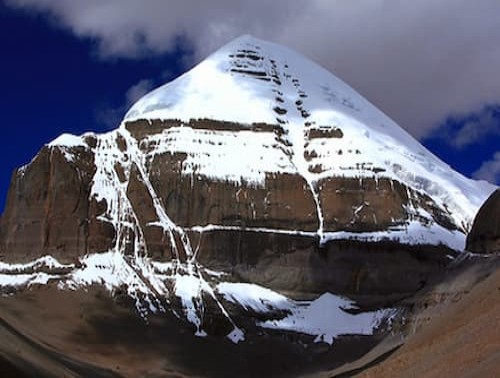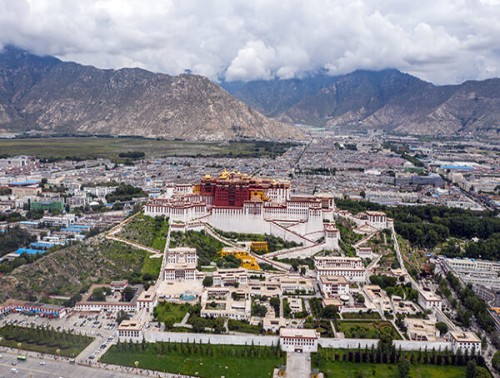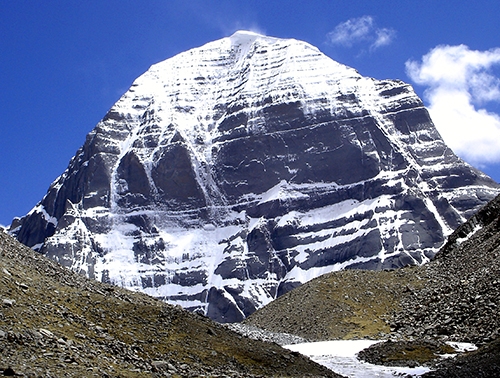Flying from Kathmandu to Lhasa
Lhasa and Kathmandu have two direct flights, both run by Sichuan Airlines and Air China. The best part of flying from Nepal to Tibet sees the Himalayas from above, including the world's highest peak, Mt. Everest.
By Road:
Tibet can be entered in this way most of the time. Many tourists fly to Kathmandu and then enter Tibet via land due to the many direct international flights available to Kathmandu. You can, however, enter Tibet through the Kerung, Simikot and Kodari borders if you are already in Nepal. The Kodari border is closed temporarily due to the 2015 earthquake in Nepal. An alternative route through Kerung, which is located 3 hours away from Kathmandu, is used. In particular, travellers who are interested in touring or trekking Kailash use the Simikot border. Near the Kerung border, you can find a lot of cars, vans, and buses.
Mainland China
Train/Railway:
The China-Tibet railway system includes five routes. The Qinghai-Tibet Railway is a popular choice. Beijing to Lhasa is a two-day journey. Tibet gets reached in 21 hours from Xining. Tibet is connected to Shanghai by train every day. It takes about 43 hours for the Chengdu-Tibet train to depart every other day. In China, the longest train ride is from Guangzhou to Tibet, which takes 54 hours.
Flights: Tibet can be reached within seven hours by air from Beijing, Shanghai, and Chengdu. The flight from Chengdu to Lhasa is especially popular in winter because of the discounts. Flying to Lhasa is accessible from Beijing, Shanghai, Chengdu, Shangrila, Kunming, Guangzhou, Chongqing, Xian, Xining and Kathmandu. Furthermore, Chengdu is also connected to Shigatse and Nyingchi in Tibet via several daily flights. The most popular way to enter Tibet is by land from mainland China, which takes seven to fifteen days. There are two major routes: the Qinghai-Tibet Highway (1937km, an estimated 5 - 7 days) and the Xinjiang-Tibet Highway (2086km, an estimated 10 - 15 days).
Passport and Visa Information
Tibet travel permits can be obtained in Kathmandu through a travel agency (Tibet via Nepal) and a Chinese visa. The Tibet Travel Permit is not the same as a valid visa for China. A Tibet travel permit is still required for those with Chinese tourist visas. For foreign travellers travelling from mainland China to Tibet, a permit is still needed. You will have to reserve a guide and pre-arrange private transportation for trips outside of Lhasa to receive the permit. In addition to the permits required outside of Lhasa.
Travel Insurance
Tibet is a remote location, so you may need to be evacuated by air if you are seriously injured or very ill. A lack of adequate health insurance isn't an option in these circumstances. It is essential to ensure you have evacuation coverage.
Banking and Foreign Exchange
Tibet follows the same currency policy as the rest of China: the Renminbi (RMB). Bank of China is the only financial institution that offers foreign exchange services. In Lhasa, several Chinese banks, including the Bank of China, China Construction Bank, Industrial and Commercial Bank of China and Agricultural Bank of China. Furthermore, some hotels with four or five stars provide exchange services. Coins are not used or accepted by Tibetans. Travellers to Shigatse, Shannan, Ngari, Nyingchi, and Nagqu, where banking services are limited, are advised to carry enough cash for their trip.
Electricity
Power sockets in Tibet are of types A, C, and I. There is a standard voltage of 220 volts and a standard frequency of 50 Hz. Consider your country has a standard voltage of 220 - 240 V (as does the UK, Europe, Australia, and most Asian and African countries).
If your country has a standard voltage in the range of 100 V - 127 V (like Canada, the United States and most of South America), a voltage converter is required in Tibet. Voltage converters might not be available in Tibetan stores so you can bring yours. Alternatives include buying them in Kathmandu (if travelling to Tibet through Nepal).
Suppose the label on your electric appliance states' INPUT: 100-240V, 50/60 Hz' the appliance is compatible with all countries. Tablet/laptop chargers, camera batteries, and cell phones often cause this situation.
Drinking water
The water from taps or ice made from fixtures is not consumed. In most hotels, including Lhasa, the water is boiled first before being served hot or cold. When trekking in remote areas, consuming boiled water or using water-purification tablets is recommended when travelling in remote areas. It would be best never to drink locally brewed alcohol as they are often made with contaminated healthy water. Tea, on the other hand, is always safe to drink. The majority of supermarkets sell large 5-litre bottles of drinking water.
In Tibet, the water is hard, so it has to be boiled at least for ten minutes to be purified. Consider buying a water filter when travelling for an extended period (often more economical than buying bottled water). Using total filters, you can ensure that your water is safe to drink since they remove all parasites, bacteria, and viruses.
The sodium chloride in chloroform tablets (e.g., Puritans, Steritabs) will kill most pathogens, but not giardia or amoebic cysts. Water can be purified with iodine in liquid (Lugol's solution) or tablet form (e.g. Potable Aqua). Use only a tiny amount of iodine and follow the directions carefully.
Best Time to Visit Tibet
Visits to Tibet are most prevalent from May to September. Clear skies and warm weather characterize the day. From April onwards, snow/ice begins to melt, clearing blocked roads, and making it easier to visit Tibetan townships. Due to the busy season, prices are at their highest level.
Visiting Tibet between April and October to November is an excellent time to save about 20% of your money. Due to the minimal number of tourists, there are many hotel and vehicle options.
Travel to Tibet is least prevalent in winter (Dec-Feb). It is freezing outside, but you have the entire place to yourself. In the off-season, hotels and vehicle rentals are considerably cheaper, which means you will pay half as much as when tourism is at its peak.
Last-minute booking on Tibet tours
Booking is the best way to execute the whole trip without any hassle. However, Eternal Himalaya does provide a last-minute booking facility for those who are unable to book in advance. For this clients are required to pay 100% of the trip cost within 24hrs before the trip departure.
In case of last-minute booking, we cannot be responsible for the delays because of the events which are beyond our control, such as weather changes, unavailability of lodges and other unfavourable conditions which lead to trip delays and flight cancellations. Despite these unfavourable circumstances we do our best to manage a trek at any time.
For more information, call us at +977 9851254672 (Ram Sharan) or email us.
Trip extension
If you want to stay a couple of days extra in Nepal, after completing your trek. We recommend you to use your spare time exploring Kathmandu valley and neighbouring places. We can provide you with a lot of options such as enjoying adventure activities - Bungee jumping, rafting, zip-flyer, cycling, and paragliding.
Feedback
You may want to give us feedback about our services after completing your trek. Please feel free to react and comment whether it is a positive or negative response we will take it as constructive criticism. After completing your Everest Base Camp Trek, our company will organize a farewell dinner and present you with a trek completion certificate.
Equipment list for Tibet Tours
Here is the complete essential list of equipment for the Tibet tours. The weight of your luggage is limited up to 9 kg, so, therefore, we advise you to carry only essential items. In case you require to carry more than 9 kg, we can arrange porters.
Head Wear
Warm insulated winter hat / Wooly hat
Sun hat / Wide-brimmed hat
Scarf
Neck gaiter or Fleece Buff (Optional)
Neoprene face mask (Optional)
Balaclava / Bally ski mask / Monkey cap (Optional)
LED Headlamp × 2 and spare batteries
Face/body care items
Sunscreen with SPF above 50
Sunglasses with UV protection × 2 pairs
Face/body cleansing wipes (biodegradable wipes)
Moisturizer lotion for face/body
Lip balm
Hand Wear
Liner gloves × 2 pairs
Fleece gloves × 2 pairs
Body Wear
Hiking shirts × 2 pairs
Full-sleeved thermal undershirts × 2 pairs
Fleece jacket
Waterproof and windproof hooded rain jacket
Down jacket (thick down jacket for winter treks)
Polypropylene underwear × 5-6 pairs
Synthetic material hiking pants × 2 pairs
Long johns × 2 pairs
Sweater
Waterproof jacket and pants
Lightweight cotton pants
T-shirt
Foot Wear
Woollen socks × 6 pairs (thick light socks)
Lightweight shoes/scandals
Hiking Boots
Essential Gear
Backpack
Day pack for basics
Waterproof covers for your bags and packs
Thermal water bottle (hydration bladder often freezes in winter)
Sleeping bag (rated at least 0°C for summer and -15° for winter)
Water purification tablets, drops or portable water purifier/filter bottles or, gadgets
Trekking pole
Crampons
Large plastic bags and stuff sacks
Personal Toiletries
Medium size towel
Toothbrush
Toothpaste
Biodegradable bar soap
Deodorant
Nail clippers
Small mirror
Toilet papers
Shampoo
Personal accessories
Money
Watch
Cell phone
Camera
Lighter
Pocket knife
Extra items / Travel gear
First aid kit
Extra passport photos and photocopies of passport Travel insurance documents
Notebook and pen
Books
Personal entertainment
Binoculars
International electrical adapter


.jpg)


